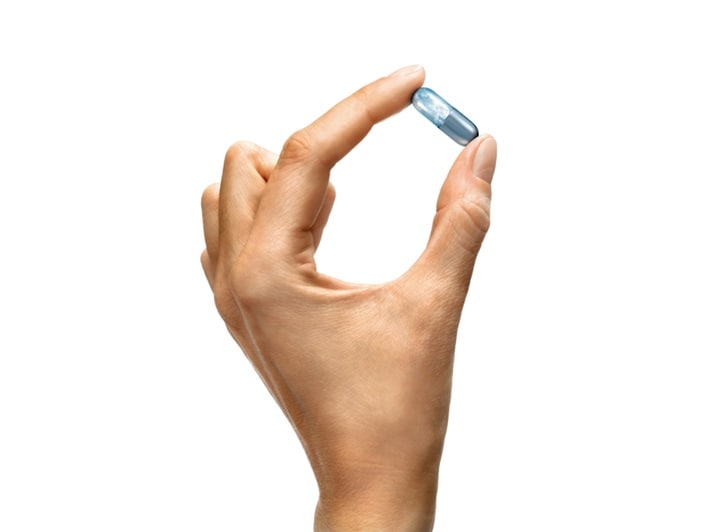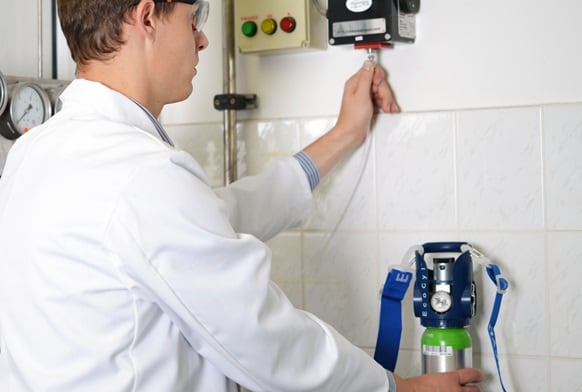
Linde Healthcare has pioneered medical gas products for many years
We are committed to working with healthcare providers and regulatory authorities to promote the best practice use of our products. We stay aligned with clinical progress and continue to design and redesign solutions that meet the unique needs of healthcare professionals and patients. We’ll support you in every aspect of the delivery and use of medical gases, including logistics, safety systems, technical solutions, and service as well as training.
Medical Gases
Ravimiregister:
● CONOXIA (gas)
● CONOXIA (liquid)
Medicinal oxygen is widely used in every healthcare setting, with applications from anaesthesia to inhalation therapy.
Quality care and safety are unquestionably critical, so it is important that oxygen is handled with the utmost diligence. L
inde Healthcare offers medicinal oxygen solutions, products and services to meet the specific requirements of the care facility or to help patients in the home.
Advances in therapeutic uses of oxygen have resulted in increased usage for a number of diverse clinical applications, among them:
- ● To treat hypoxia and hypoxaemia.
- ● During surgery to maintain tissue oxygenation under anaesthesia, as well as pre-operative and post-operative uses on the ward.
- ● As part of resuscitation.
- ● In mechanical lung ventilation for the treatment of respiratory depression.
- ● In the treatment of diseases such as chronic obstructive lung disease (COPD), pneumoconiosis, pneumonia, heart attack and pulmonary embolism.
- ● To treat respiratory distress syndrome in newborns.
- ● In the treatment of respiratory burns and as part of the gold standard of care for carbon monoxide poisoning.
Medicinal oxygen is subject to rigorous regulations with regards to the production, handling and use. We follow strict guidelines in manufacturing, control and distribution. In addition, as your healthcare partner, we do more than supply high quality oxygen. We can provide the expertise, training and support needed to ensure that the oxygen is delivered safely every time needed.
Ravimiregister:
● NIONTIX
Medicinal nitrous oxide has played an important role in anaesthesia over many years.
Medicinal nitrous oxide is used as an anaesthetic and analgesic agent:
- ● It acts synergistically when combined with other inhaled or intravenous anaesthetic agents.
- ● It has little effect on respiration and circulation during anaesthesia. Spontaneous breathing is preserved more effectively by using the combination of medicinal nitrous oxide and any of the commonly used inhaled anaesthetics rather than when using only a potent inhaled anaesthetic.
- ● Its rapid „wash-in“ (uptake) and ‘wash-out’ (fast elimination) together with its ability to maintain spontaneous respiration allow faster emergence when used with a modern inhaled anaesthetic than when the anaesthetic is used alone.
Ravimiregister:
● ENTONEX
With fast onset and offset for analgesia or sedation, medicinal nitrous oxide/oxygen mixture is used throughout hospitals and clinics.
ENTONOX®, medicinal nitrous oxide/oxygen mixture, is used in paediatrics, obstetrics, and for procedural pain. The low solubility of nitrous oxide in biological tissue and fluid means, in clinical practice, that medicinal nitrous oxide/oxygen mixture
provide rapid pain relief and elimination of the gas from the lungs. A further safety feature is the composition of ENTONOX consisting of 50% nitrous oxide and oxygen to prevent hypoxia during administration.
ENTONOX is administered by inhalation, so there is no need to insert a cannula or set up an intravenous line. This means that this form of analgesia/sedation does not need to be administered by a specialist anaesthetist, but can be administered by trained staff such.
Ravimiregister:
● AIRAPY
A reliable supply of medicinal air is essential in hospitals, especially in the treatment of respiratory diseases.
In hospitals, medicinal air is used mainly for ventilation and aerosol therapy and during anaesthesia:
- ● When treating respiratory diseases such as asthma and COPD, an effective way of delivering drug treatment is to direct it straight to the lungs by inhalation. Nebulisers are used to administer inhaled medication to patients who cannot use conventional inhalers. Medicinal air may be used to drive the drug treatment air to the nebuliser where liquid medication is converted to a mist that can be inhaled.
- ● Medicinal air is used as a carrier gas for narcotic substances in inhalational anaesthesia. It may also be used with nitric oxide as a substitute for supplemental oxygen to reduce the high concentration of oxygen exposure.
- ● Some patients are dependent on a reliable, high quality supply of medicinal air to protect their delicate and sensitive respiratory systems.
The therapeutic use of inhaled nitric oxide is based on its ability to achieve potent and sustained pulmonary vasodilation, without significantly decreasing systemic vascular tone.
Linde Healthcare has developed a complete solution, INOmax® Therapy, for the delivery of inhaled nitric oxide. Our solution integrates a dedicated system for administration, gas calibration, treatment recording, customer training and service support to
ensure the most effective results with maximum patient safety. The delivery device, INOvent®, fits every sort of ventilatory support mode and enables constant monitoring of delivered nitric oxide, oxygen and nitrogen dioxide.
In conjunction with ventilatory support and other appropriate agents, INOmax is indicated for the treatment of newborns ≥ 34 weeks gestation with hypoxic respiratory failure associated with clinical or echocardiographic evidence of pulmonary hypertension, in order to improve oxygenation and to reduce the need for extracorporeal membrane oxygenation.
- CONOXIA®
- NIONTIX®
- ENTONOX®
- AIRAPY®
- INOmax®
CONOXIA® - Medicinal Oxygen

Medicinal oxygen is widely used in every healthcare setting, with applications from anaesthesia to inhalation therapy.
Quality care and safety are unquestionably critical, so it is important that oxygen is handled with the utmost diligence. Linde Healthcare offers medicinal
oxygen solutions, products and services to meet the specific requirements of the care facility or to help patients in the home.
Advances in therapeutic uses of oxygen have resulted in increased usage for a number of diverse clinical applications, among them:
● To treat hypoxia and hypoxaemia.
● During surgery to maintain tissue oxygenation under anaesthesia.
● As part of resuscitation.
● In mechanical lung ventilation for the treatment of respiratory depression.
● In the treatment of diseases such as chronic obstructive pulmonary disease (COPD), pneumoconiosis, pneumonia, heart attack and pulmonary embolism.
● To treat respiratory distress syndrome in newborns.
● For cluster headaches.
● In the treatment of respiratory burns and as part of the gold standard of care for carbon monoxide poisoning.
Medicinal oxygen is subject to rigorous regulations with regards to the production, handling and use. We follow strict guidelines in manufacturing, control and distribution.
In addition, as your healthcare partner, we do more than supply high quality oxygen. We can provide the expertise, training and support needed to ensure that the oxygen is delivered safely every time needed.

Calibration Gases
Calibration gases are essential to ensure the accuracy of the medical devices that are a crucial part of modern medical care.
Essential medical devices such as blood gas analysers require regular calibration to ensure continuing high levels of reliability and accuracy, and therefore accurate diagnoses and appropriate treatment for patients.
Supporting this important aspect of the operation of medical devices, Linde Healthcare provides calibration gas mixtures according to the specifications of each device manufacturer.
HBO – Hyperbaric Oxygen
HBO is an accepted treatment for decompression sickness. HBO means that the patient is given pure oxygen at an air pressure that is increased to 2 to 3 times normal air pressure. This treatment is given in hyperbaric chambers which are available at a number of special clinics. By giving such treatment, it is possible to increase oxygenation in the tissues to around 10 times higher values than when air is breathed at normal air pressure. The treatment is used in various conditions when good oxygenation is to be achieved out in the tissues and can also be used to get rid of carbon monoxide from the blood more quickly in carbon monoxide poisoning and in decompression sickness when too rapid ascent has led to nitrogen being dissolved in the body and needing to be eliminated.
Downloads:
Brugsanvisning medicinsk kuldioxid


Lung Test Gases
Lung Test Gases are a key component when assessing lung function and cardiac output.
Lung Test Gases consist of gas mixtures containing a tracer gas. During the test, the exhaled gas is analysed and differences in the concentration of the tracer gas can
be used to measure pulmonary function or lung blood flow. When used in conjunction with diagnostic equipment, these gas mixtures
measure different functions of the lungs to help in assessing patients with serious lung disorders such as asthma, chronic obstructive pulmonary disease or interstitial lung disease.
A typical lung function gas comprises a mixture of carbon monoxide and helium with the balance being oxygen and nitrogen. The carbon monoxide is used to test the transfer functionality of the lungs and helium helps to determine lung volume.
Carbon Dioxide (Medical Device)
Carbon dioxide is used as an insufflation gas and as a cooling agent.
Carbon Dioxide(Medical Device) has various medical purposes. It can be used as an insufflation gas for minimal
invasive surgery (laparoscopy, endoscopy, and arthroscopy) to enlarge and stabilize body cavities for better visibility of the surgical field. Also,
in its liquid phase, it can be used to provide temperatures down to -76° C, for cryotherapy or for local analgesia by external application onto the skin surface.
Other medical applications include transient respiratory stimulation and encouragement of deep breathing and coughing to prevent or treat atelectasis.


Nitrogen
Nitrogen (Medical device) is currently not available. For additional information please contact us by calling or e-mailing.
Nitrogen has various medical uses, especially in liquid form when it provides temperatures as low as -196°C.
Helium/Oxygen Mixture
The range of uses of Helium/Oxygen Mixture have expanded considerably, and most uses depend on its low density. Helium/oxygen mixture may assist the flow of oxygen in the airway for patients with severely obstructed airways in conditions such as upper airway obstruction, asthma, chronic obstructive pulmonary disease (COPD), bronchiolitis and croup. Patients with these conditions may suffer a range of symptoms including breathlessness, below-normal oxygen content in the arterial blood and eventually a weakening of the respiratory muscles due to exhaustion. Helium/oxygen mixture may reduce these effects, making it easier for the patient to breathe, and as it will reduce work of breathing, help to prevent respiratory failure.

 Downloads
Downloads
| Product data sheets and brochures | |
|---|---|




